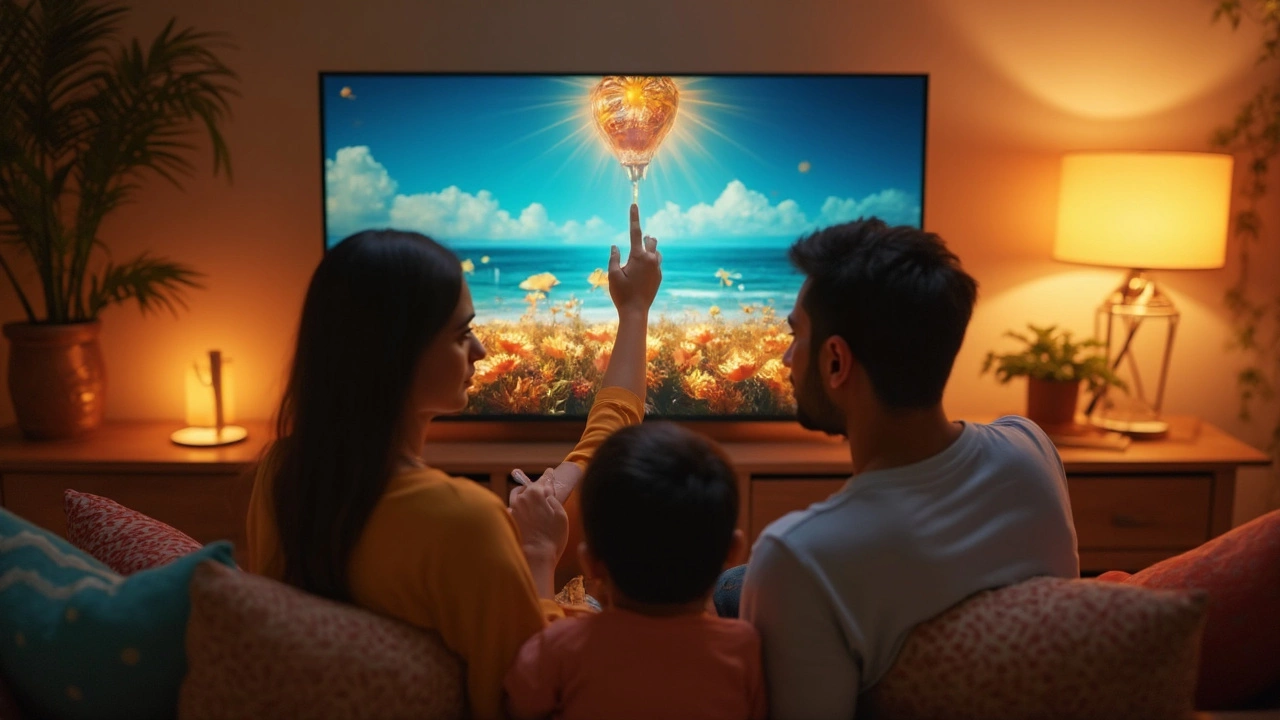
People throw around the terms 1080p and 4K like it's night and day, but is it really? If you sit down in front of a new 4K TV, will your eyes instantly spot the difference, or is it hype wrapped in tech jargon?
The short answer: It depends. Not just on your eyesight, but also on how big your TV is and how close you sit to it. There’s a lot more to these numbers than marketing makes it seem.
If you’ve ever tried showing off your fancy new 4K screen to friends only for them to shrug and say it looks "nice," you're not alone. Even in tech labs, when people are asked to pick out 4K from 1080p on average-sized TVs, the results aren’t all that impressive unless they’re really paying attention—or sitting way too close for comfort.
- What Does 4K Really Mean?
- Can Most People Spot the Difference?
- Screen Size and Viewing Distance: The Real Factors
- When Upgrading Makes Sense—and When It Doesn’t
What Does 4K Really Mean?
You’ve probably seen 4K plastered across TV ads, but what’s behind the label? In simple terms, 4K TVs have about four times as many pixels as standard 1080p TVs. The big number isn’t just for bragging rights—it’s all about pixel count and clarity. A 1080p TV has 1,920 across and 1,080 top to bottom, while a 4K TV bumps that up to 3,840 by 2,160. That’s over 8 million pixels packed into your screen versus just over 2 million on a full HD display.
Check out the numbers side-by-side:
| 1080p (Full HD) | 4K (Ultra HD) | |
|---|---|---|
| Resolution | 1920 x 1080 | 3840 x 2160 |
| Total Pixels | 2,073,600 | 8,294,400 |
| Common TV Labels | Full HD, 1080p | 4K TV, Ultra HD, UHD |
So when you hear “4K,” think of those extra pixels making everything on screen sharper—at least in theory. But here’s the thing: you only get the full effect if you’re close enough or the TV screen is big enough for your eyes to even catch the difference. Otherwise, it might feel the same as what you already have.
Another catch? Not all videos are shot in 4K. Streaming platforms like Netflix, Disney+, or Prime Video offer 4K content, but often at a higher subscription tier, and you’ll need a fast internet connection to actually watch in 4K. Broadcast TV and most YouTube videos still mainly stick to 1080p. So the tech is there, but only part of what you actually watch will use it.
Can Most People Spot the Difference?
If you gather ten people in a living room, most probably won’t call out which TV is 1080p and which is 4K right away, unless the screen is huge or they’re sitting uncomfortably close. The difference between resolutions is a lot less obvious than most advertising suggests.
On a standard 55-inch TV, the pixels in a 4K TV are four times smaller than on a 1080p TV, but our eyes have limits. At normal viewing distances—say, seven to ten feet—the added detail from 4K can be super hard to see. A recent blind test by RTINGS.com, a site that’s actually obsessed with display quality, had people check screens side-by-side. Over 60% said they couldn’t spot the upgrade unless sitting less than five feet from the screen. Who watches TV that close unless they lost the remote?
Here’s a quick look at how distance affects what you see:
| Screen Size | Best Viewing Distance for 4K | Best Viewing Distance for 1080p |
|---|---|---|
| 50" | 3.5 – 5.5 ft | 7 – 10 ft |
| 65" | 4.5 – 6.5 ft | 9 – 13 ft |
Another wild fact: under age 40, most people can see about 60 pixels per degree, but by age 60, that drops, making the difference between 1080p and 4K even less obvious. And let’s be honest, streaming services compress 4K content so much that sometimes it barely looks better than 1080p anyway—unless you’ve got a top-tier plan and fast internet.
If you’re comparing high-res nature documentaries or 4K YouTube on a big screen right up close, you’ll probably notice a jump in sharpness. Go back to Netflix on a regular night from across the room? Not so much. The real difference comes down to your room setup and what you watch.

Screen Size and Viewing Distance: The Real Factors
If you want to know whether you’ll actually notice the jump from 1080p to 4K, you have to look at two things: how big your TV is and how close you sit to it.
It sounds simple, but here’s the deal—if you’re rocking a 43-inch screen and sitting 10 feet away, most folks can’t tell the difference between 1080p and 4K. The higher pixel count just gets lost at that distance. On the flip side, if you’ve got a 65-inch or bigger screen and you’re sitting closer, the crispness pops out much more.
The science backs this up. Your eyes have limits—there’s only so much detail they can pick out at certain distances. TV geeks often talk about visual acuity, which is a fancy way of saying how much sharpness your eyes can see. If your eyes can’t resolve those tiny extra pixels, you’re just paying extra for numbers you can’t appreciate.
Check out this handy table for some quick reference. It shows the ideal distance to actually see the boost from 4K compared to 1080p, based on your screen size:
| Screen Size (inches) | Ideal Distance to Notice 4K (feet) | Typical Living Room Distance (feet) |
|---|---|---|
| 43" | Under 5.5 | 6-10 |
| 55" | Under 7 | 7-12 |
| 65" | Under 8.5 | 8-13 |
| 75" | Under 10 | 9-15 |
So, if your couch is across the room, you’ll need a pretty massive screen to really get those 4K details. If your living room isn’t set up for that, 1080p might do the trick. Here’s a quick tip: Before you splurge on a 4K TV, measure how far you usually sit from your TV. Then check what screen size actually makes sense for your space.
- If you can sit closer without feeling awkward, you’ll notice the upgrade more.
- If you’re locked into a bigger gap, only a really large screen will show big improvement.
- Always test this in-store if you can—stand at your actual viewing distance and see if you spot a difference.
When Upgrading Makes Sense—and When It Doesn’t
Before dropping cash on a new TV, think about what you’re really getting out of a move to 4K. The truth is, not everyone needs to upgrade. Here’s how to figure out if it actually benefits you or if you’ll just be chasing specs you don’t need.
Most folks get the wow factor from 4K only if some key boxes are checked:
- 4K TV is 55 inches or larger. Smaller screens just won’t show off all those extra pixels unless you’re glued to the glass.
- You watch a lot of true 4K content, like Netflix Originals, Disney+, or a 4K Blu-Ray. Regular cable and even some streaming shows are still stuck at 1080p or lower.
- Your seating distance fits the ‘sweet spot’. For example, with a 65-inch 4K set, you’ll want to sit about 4 to 6.5 feet away to actually see the sharper picture.
- You want future-proofing. If you’re planning to keep your TV for the next 5–7 years, going 4K is the safer bet.
On the other hand, reasons to stick with your current 1080p TV are just as legit:
- Your TV is 50 inches or smaller and you sit further than 7 feet away—your eyes probably can’t tell the difference.
- You mostly watch sports, news, or cable where channels barely touch anything beyond 1080p. Even a fancy panel can’t fake better quality.
- You’re on a budget or thinking about upgrading audio, a streaming box, or lighting instead. Those changes often make a bigger impact on your setup.
Check out this simple table to see where the real viewing benefits show up based on screen size and distance:
| TV Size | Recommended Viewing Distance for 4K | Chance You’ll Notice 4K Over 1080p |
|---|---|---|
| 43" | 3 – 5 ft | Low |
| 55" | 4 – 7 ft | Medium (closer = better) |
| 65" | 4 – 8 ft | High (center sweet spot) |
| 75" | 5 – 9 ft | Very High |
If you want a hands-down difference, go bigger or get closer. But if your space or habits don’t line up, your 1080p set isn’t suddenly outdated. Save your money if you’re still watching reruns or your go-to shows don’t offer 4K anyway.